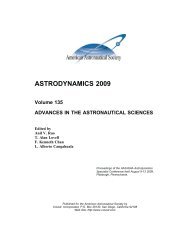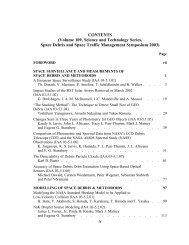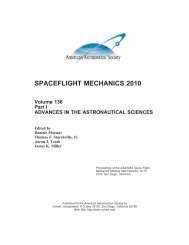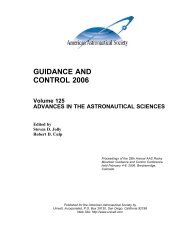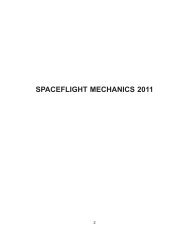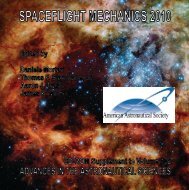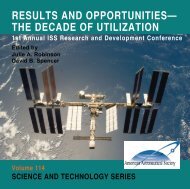information. - Univelt
information. - Univelt
information. - Univelt
- No tags were found...
You also want an ePaper? Increase the reach of your titles
YUMPU automatically turns print PDFs into web optimized ePapers that Google loves.
AAS 12-053SIMULATION RESULTS OF RENDEZVOUS AND DOCKINGWITH THE INTERNATIONAL SPACE STATIONUSING ONLY 3D RANGE IMAGESReuben R. Rohrschneider, * William Tandy, †Jeff Bladt * and Ian J. Gravseth *NASA’s future plans for space vehicles call for the ability to automatically rendezvousand dock (AR&D) with the International Space Station (ISS) and other targets.This requires sensors and algorithms capable of determining the relative position andorientation (pose) between the target and chase vehicles under the drastically varyinglighting conditions of low Earth orbit and beyond.To this end, Ball Aerospace has developed algorithms to produce six degree-of-freedomnavigation data from 3D point clouds. The algorithms require a-prioriknowledge of the target vehicle geometry and a range image of the target vehicle forin-flight pose determination (no visible or reflective targets are needed). The algorithmshave been incorporated into a simulation that includes a flash LIDAR model, orbital dynamics,vehicle thrust control, and a three-dimensional model of the ISS. The flashLIDAR is used as the only relative navigation sensor during AR&D. In this paper wepresent the results of the docking simulation, including the accuracy of the pose determinationalgorithms during a successful approach and docking with ISS.[View Full Paper]* Spacecraft Systems Engineer, Ball Aerospace & Technologies Corp., 1600 Commerce Street, Boulder, Colorado80305, U.S.A.† Structural Engineer, Ball Aerospace & Technologies Corp., 1600 Commerce Street, Boulder, Colorado 80305,U.S.A.24



